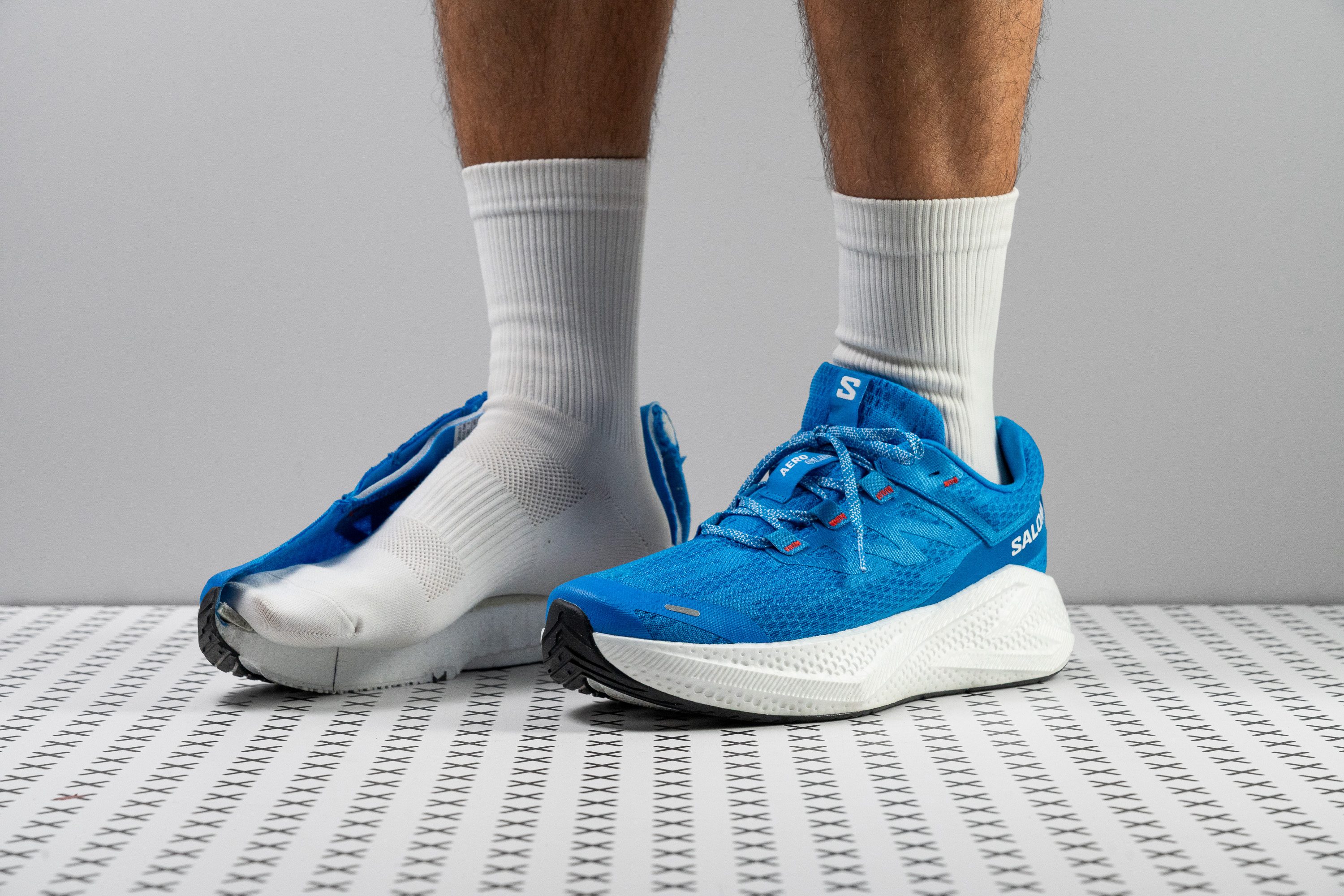Our verdict
- Top pick in best Salomon running shoes
Pros
- Surprinsingly light for its size
- Improved energy return
- Maximalist cushioning from heel to toe
- Smooth, natural-feeling rocker
- Innovative inside-out upper construction
- Solid ventilation
- Handles long runs with ease
- Good grip
- Premium quality materials
Cons
- Pricier than most competitors
- Tight fit and tapered toebox
- Upper and outsole durability concerns
Audience verdict
- Top 3% in road running shoes
- Top 5% in Salomon running shoes
Comparison
The most similar running shoes compared
+ + Add a shoe | |||||
|---|---|---|---|---|---|
| Audience score | 92 Superb! | 92 Superb! | 86 Good! | 76 Decent! | |
| Price | $160 | $180 | $165 | $180 | |
| Pace | Daily running | Daily running | Daily running | Daily runningTempo | |
| Arch support | Neutral | Neutral | Neutral | Neutral | |
| Weight lab Weight brand | 8.7 oz / 248g 8.6 oz / 245g | 10.2 oz / 289g 10.1 oz / 285g | 10.3 oz / 293g 10.2 oz / 289g | 9 oz / 255g 9 oz / 255g | |
| Lightweight | ✓ | ✗ | ✗ | ✗ | |
| Drop lab Drop brand | 10.3 mm 8.0 mm | 9.6 mm 10.0 mm | 10.3 mm 10.0 mm | 9.0 mm 8.0 mm | |
| Strike pattern | Heel | HeelMid/forefoot | Heel | HeelMid/forefoot | |
| Size | Slightly large | True to size | True to size | - | |
| Midsole softness | Balanced | Soft | Soft | Soft | |
| Difference in midsole softness in cold | Small | Small | Normal | Small | |
| Toebox durability | Bad | Decent | Decent | Bad | |
| Heel padding durability | Decent | Good | Good | Good | |
| Outsole durability | Decent | Good | Good | Decent | |
| Breathability | Moderate | Moderate | Breathable | Breathable | |
| Width / fit | Narrow | Medium | Medium | Narrow | |
| Toebox width | Narrow | Medium | Medium | Narrow | |
| Stiffness | Moderate | Stiff | Moderate | Stiff | |
| Torsional rigidity | Stiff | Stiff | Stiff | Stiff | |
| Heel counter stiffness | Flexible | Moderate | Moderate | Flexible | |
| Rocker | ✗ | ✗ | ✗ | ✓ | |
| Heel lab Heel brand | 42.2 mm 40.0 mm | 42.3 mm 45.0 mm | 38.5 mm 38.0 mm | 45.4 mm 46.0 mm | |
| Forefoot lab Forefoot brand | 31.9 mm 32.0 mm | 32.7 mm 35.0 mm | 28.2 mm 28.0 mm | 36.4 mm 38.0 mm | |
| Widths available | Normal | NormalWideX-Wide | NormalWideX-Wide | Normal | |
| Orthotic friendly | ✓ | ✓ | ✓ | ✓ | |
| Season | All seasons | All seasons | SummerAll seasons | SummerAll seasons | |
| Removable insole | ✓ | ✓ | ✓ | ✓ | |
| Ranking | #8 Top 3% | #19 Top 6% | #174 Top 48% | #342 Bottom 6% | |
| Popularity | #110 Top 30% | #7 Top 2% | #14 Top 4% | #141 Top 39% |
Who should buy
We believe the Aero Glide 3 from Salomon is a smart pick for:
- Runners who found the Aero Glide 2 decent but wanted more bounce and cushion—this update feels miles ahead.
- Anyone looking for a lightweight, ultra-cushioned trainer built with high-quality materials.
- Those who want strong protection for long runs without a super-aggressive rocker.
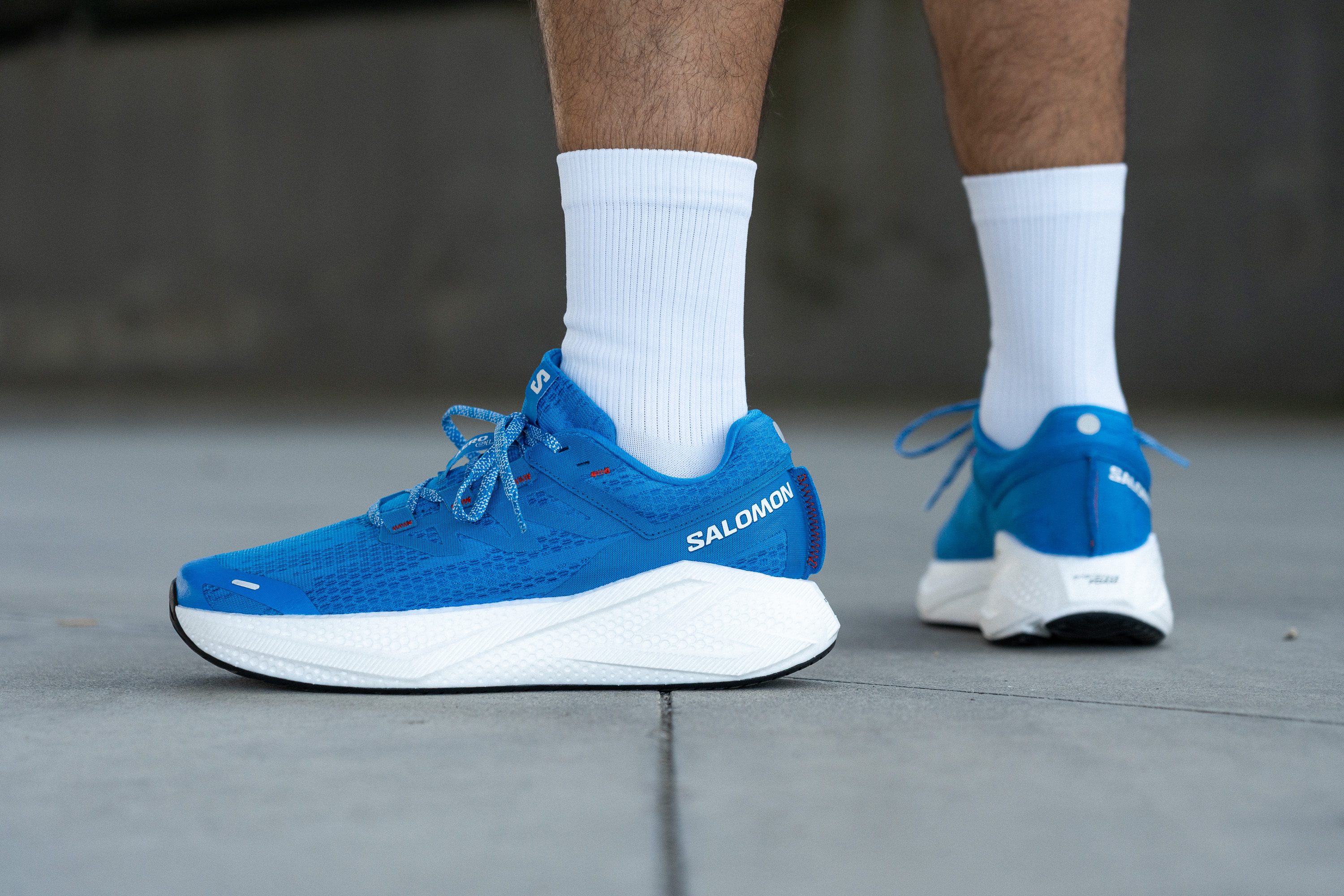
Who should NOT buy
From our perspective, the Aero Glide 3 doesn’t quite work for runners with average or wide feet, as the narrow shape and tapered toebox feel overly tight and can get uncomfortable. If you want a roomier yet still max-cushioned ride, the ASICS Novablast 5 nails it—and it’s easier on the wallet too.
We also found that durability isn’t one of the Aero Glide 3’s strengths. Through our evaluation, both the outsole and upper showed signs of fast deterioration. For high-mileage runners, we think the Brooks Hyperion Max 2 or Adidas Adizero EVO SL are better picks.

Cushioning
Shock absorption
We wish every shoe update followed the same game-changing formula as the switch from the Aero Glide 2 to the Aero Glide 3... it simply feels so much better underfoot. Now it delivers plush-and-powerful cushioning, not just because there’s more foam, but because the compound itself performs at a higher level.
In our lab, we tested shock absorption and discovered a jaw-dropping 156 SA in the heel and a still-impressive 121 in the forefoot—making this one of the most comfort-optimized midsoles we’ve seen in a daily trainer.
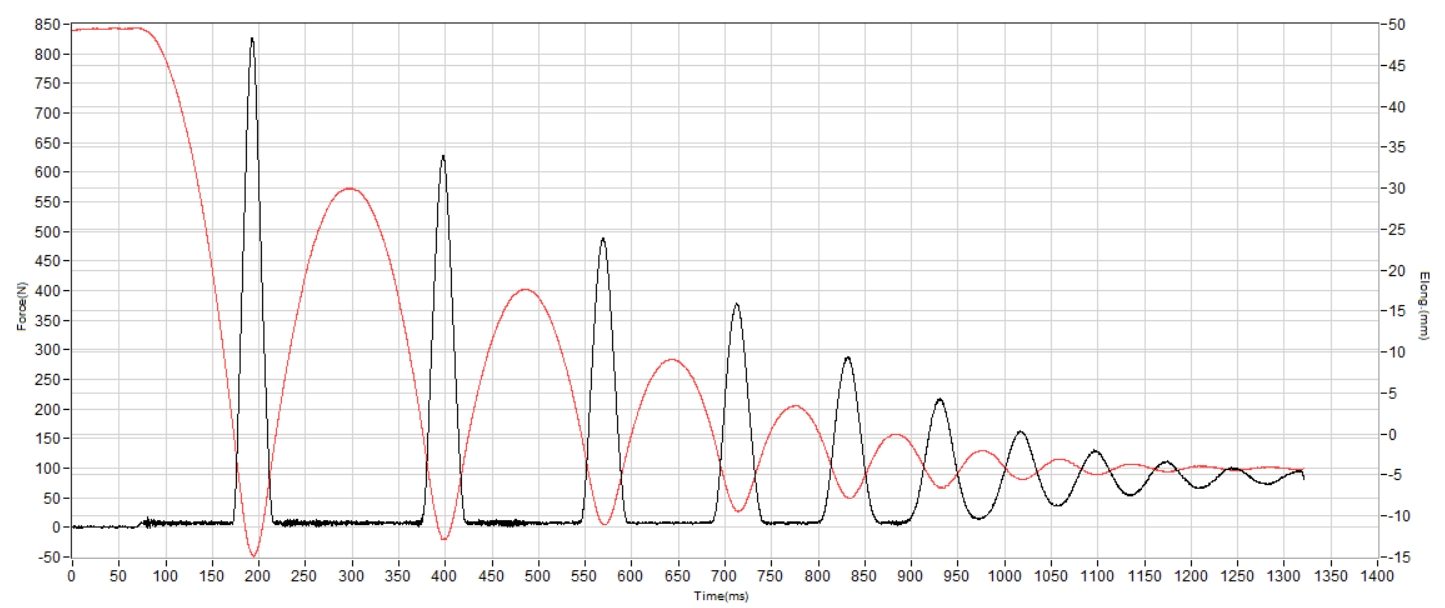
| Aero Glide 3 | 156 SA |
| Average | 130 SA |
Energy return
Salomon took a major leap forward with the Aero Glide 3 midsole in every way. It went from a middle-tier, flat-feeling shoe to a spring-loaded trainer that scored an impressive 68.0% in our lab test.
Thanks to this bounce-enhanced ride, it now feels much better during uptempo efforts and shines on demanding long runs.
| Aero Glide 3 | 68.0% |
| Average | 58.7% |
Heel stack
The Aero Glide 3 finally goes over the 40 mm mark in the heel. This time, we measured a solid 42.2 mm using our digital calipers. Interestingly, the Aero Glide 2 only had 35.5 mm despite claiming 41 mm in the spec sheet.
That ultra-cushioned design makes it a go-to option for those who crave plush landings and for heavier runners looking for extra joint protection. With this kind of stack, it’s clear that impact absorption won’t be a concern.
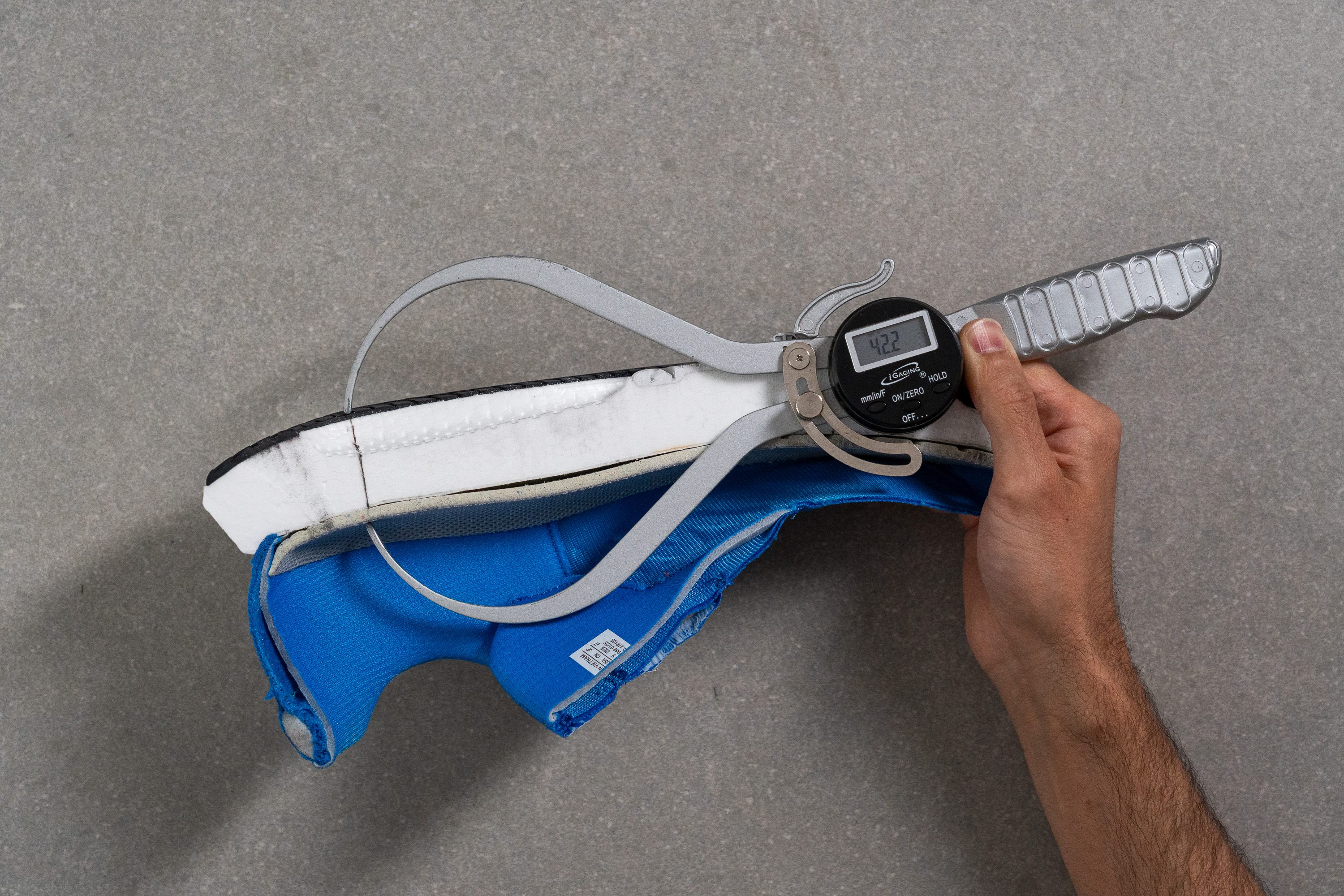
| Aero Glide 3 | 42.2 mm |
| Average | 34.8 mm |
Forefoot stack
The forefoot impressed us as well, coming in at 31.9 mm and clearing the 30 mm barrier with ease. In other words: midfoot and forefoot strikers who want maximum impact protection will feel right at home too.
It’s also a massive upgrade in cushioning compared to version 2, which clocked just 24.2 mm in this same test and featured a noticeably slimmer forefoot.
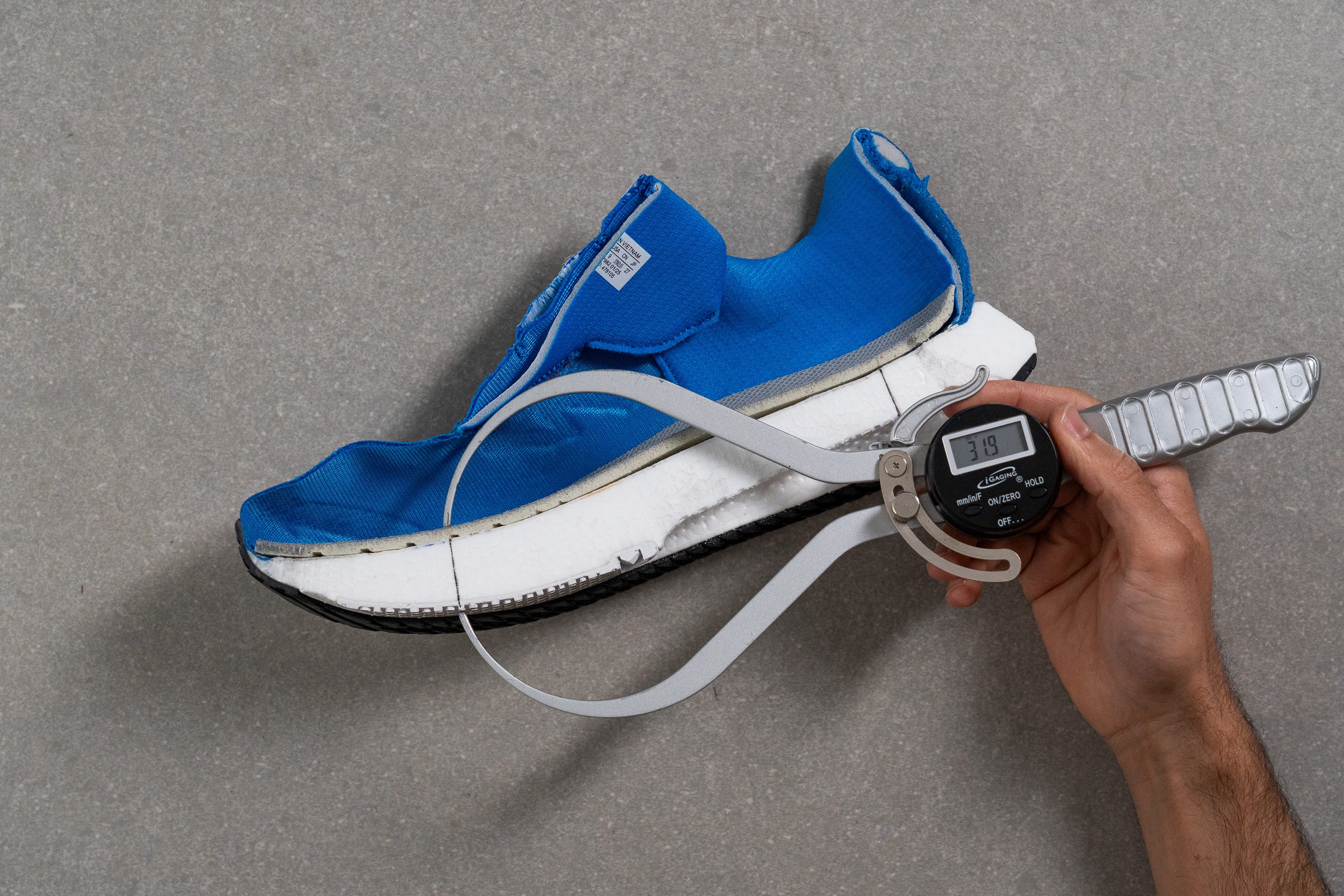
| Aero Glide 3 | 31.9 mm |
| Average | 26.1 mm |
Drop
We measured a 10.3 mm drop using our digital calipers—slightly more than the 8 mm stated by Salomon. The difference is small, but the Aero Glide 3 may feel extra-friendly for heel strikers now.

| Aero Glide 3 | 10.3 mm |
| Average | 8.6 mm |
Midsole softness
The midsole upgrade stands out not only for its taller stack but also for the foam itself.
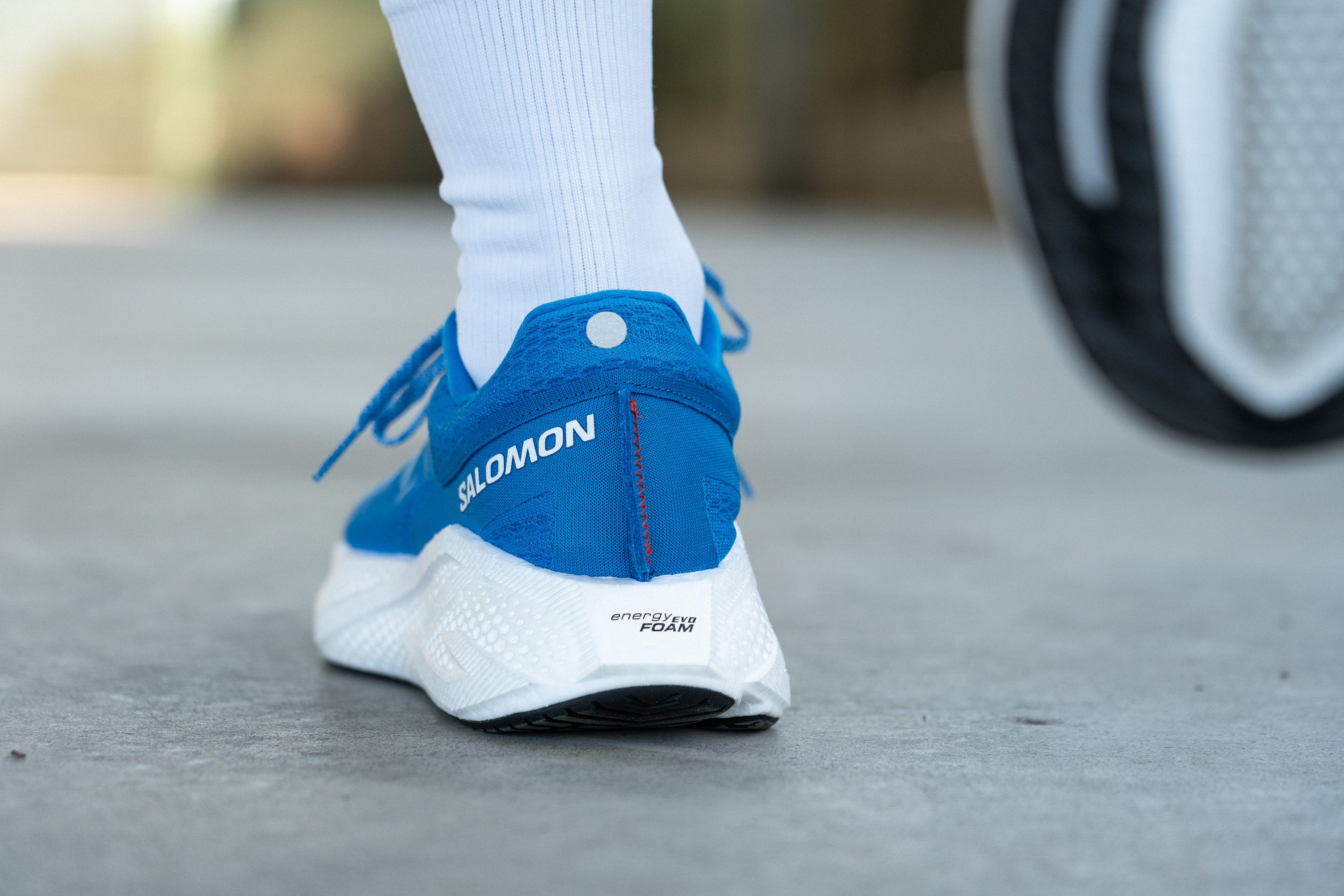
Salomon switched from Energy Foam to Energy Foam EVO, a change from EVA to an eTPU blend that feels smoother and more responsive. And on top of that, it's lighter too.
We tested its softness and got a 21.0 HA reading, which sits in a sweet spot for a max-stack shoe. While some runners may want ultra-plush landings, that would’ve made the Aero Glide 3 potentially too unstable.

| Aero Glide 3 | 21.0 HA |
| Average | 20.4 HA |
Rocker
One of the most interesting features of the Aero Glide 3 is that, unlike most ultra-thick competitors, it sticks to a fairly classic rocker with only a mild curve in the heel and forefoot.
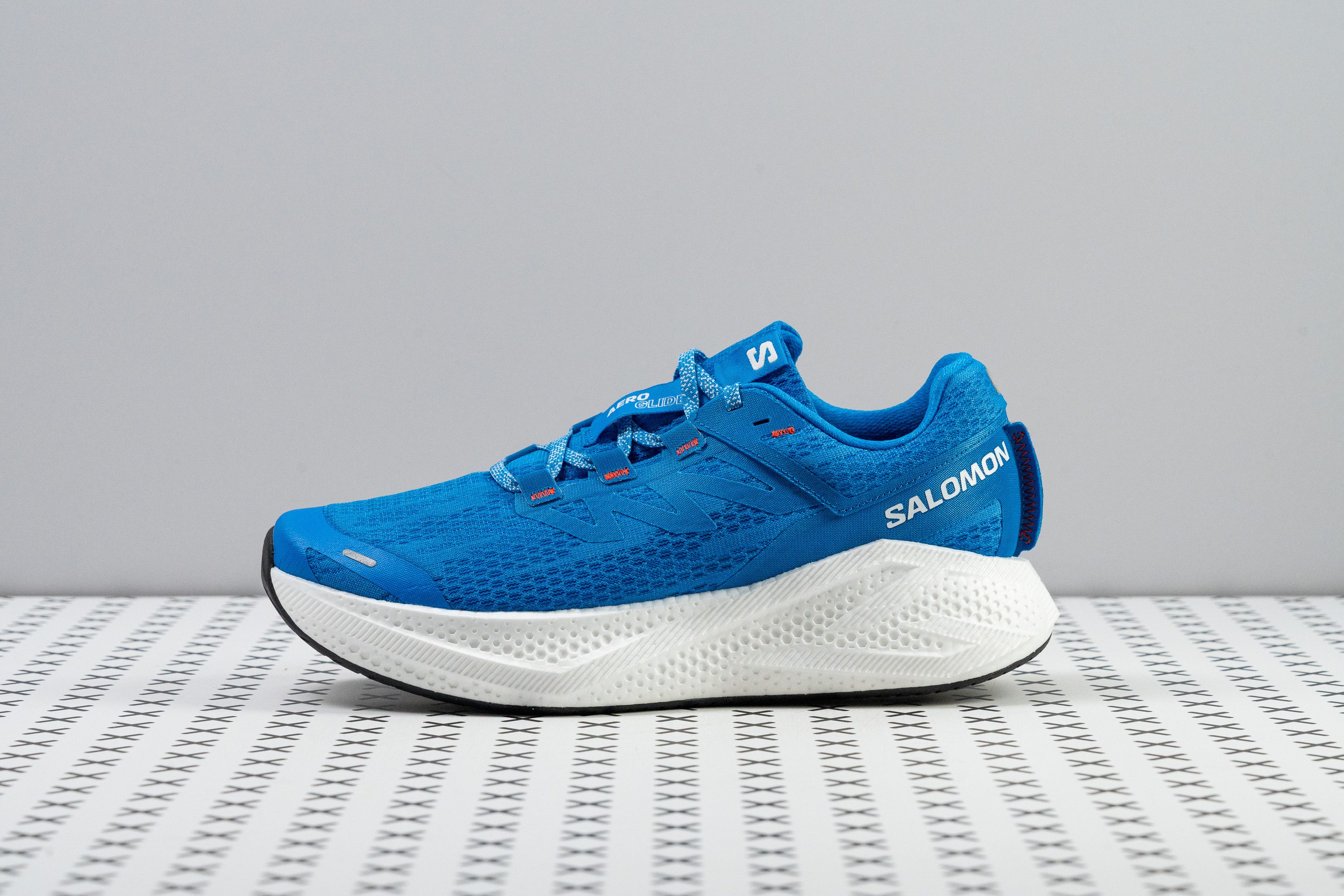
This creates a more natural-feeling ride and makes the shoe more comfortable for walking. We also think it’s a refreshing option for runners who prefer that unassisted running feel but also want to enjoy the benefits of a modern max-stack build.

Size and fit
Size
Salomon Aero Glide 3 fits slightly large (70 votes).
Width / Fit
When we tried on the Aero Glide 3 after receiving the pair we purchased, we immediately sensed it wasn’t a roomy shoe—it actually felt quite snug.
And once we began our series of measurements, that impression was quickly confirmed. At 92.8 mm in width, it clearly leans toward the narrow side compared to almost any other running shoe.

| Aero Glide 3 | 92.8 mm |
| Average | 95.1 mm |
Toebox width
The Aero Glide 3 doesn’t just run narrow overall, it also features a tapered toebox that measures only 70.8 mm in the big toe area. So yes, there’s definitely limited space for natural toe splay.

| Aero Glide 3 | 70.8 mm |
| Average | 73.3 mm |
Toebox height
While the shoe feels tight in horizontal space, vertical clearance is far more generous, measuring 28.8 mm in height.
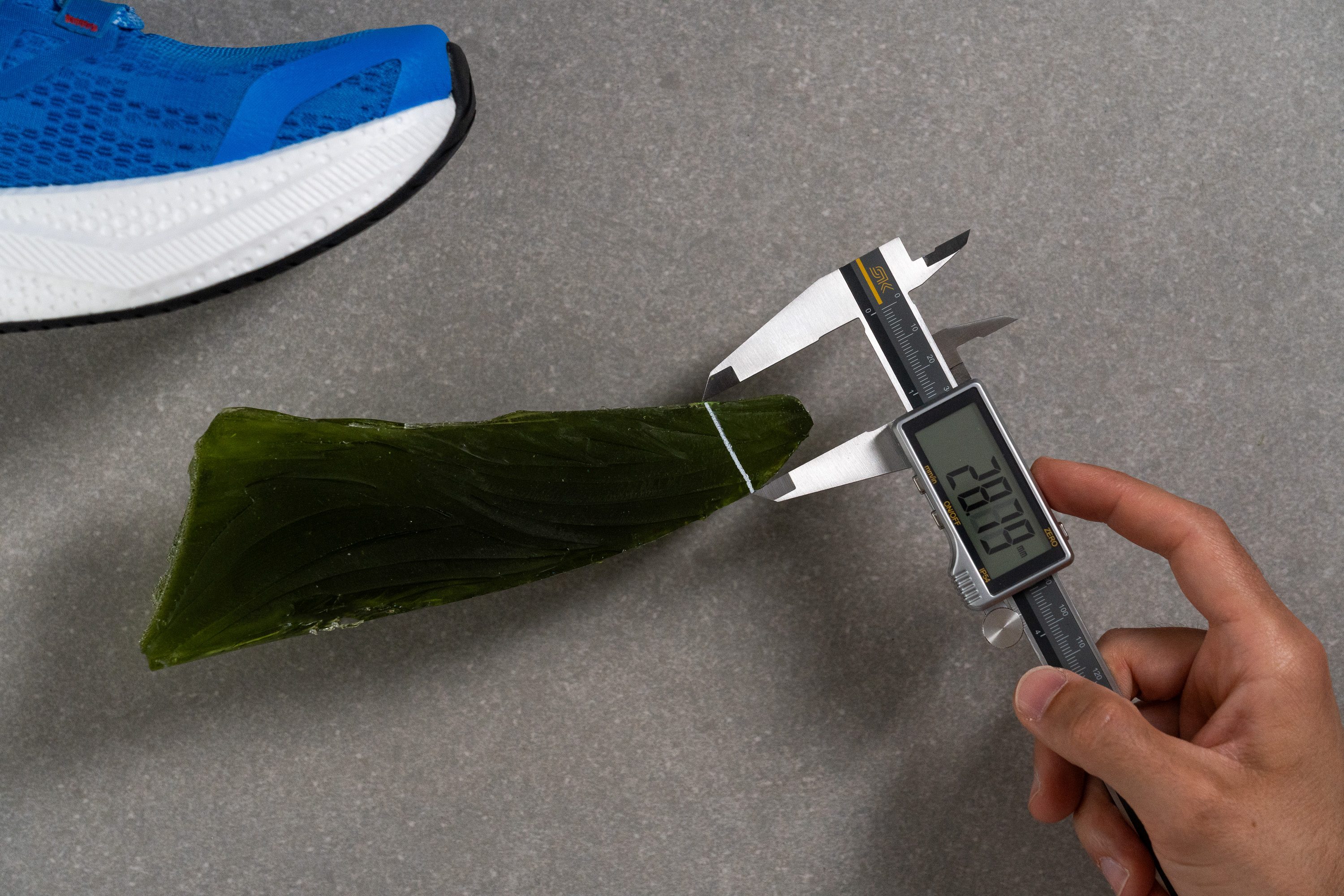
| Aero Glide 3 | 28.8 mm |
| Average | 27.1 mm |
Traction / Grip
Traction test
Salomon has decades of trail-focused expertise with its CONTAGRIP rubber, and the Aero Glide 3 clearly benefits from that legacy to post a strong 0.49 grip score in our lab. This means reliable traction on both dry and wet surfaces for all-weather runs.
| Aero Glide 3 | 0.49 |
| Average | 0.47 |
Outsole design
The outsole of the Aero Glide 3 uses CONTAGRIP rubber compound arranged in long segments on both sides of the foot. There’s also a lot of exposed EVA foam, along with a small textured cutout in the forefoot that makes the Aero Glide 3 really lightweight.
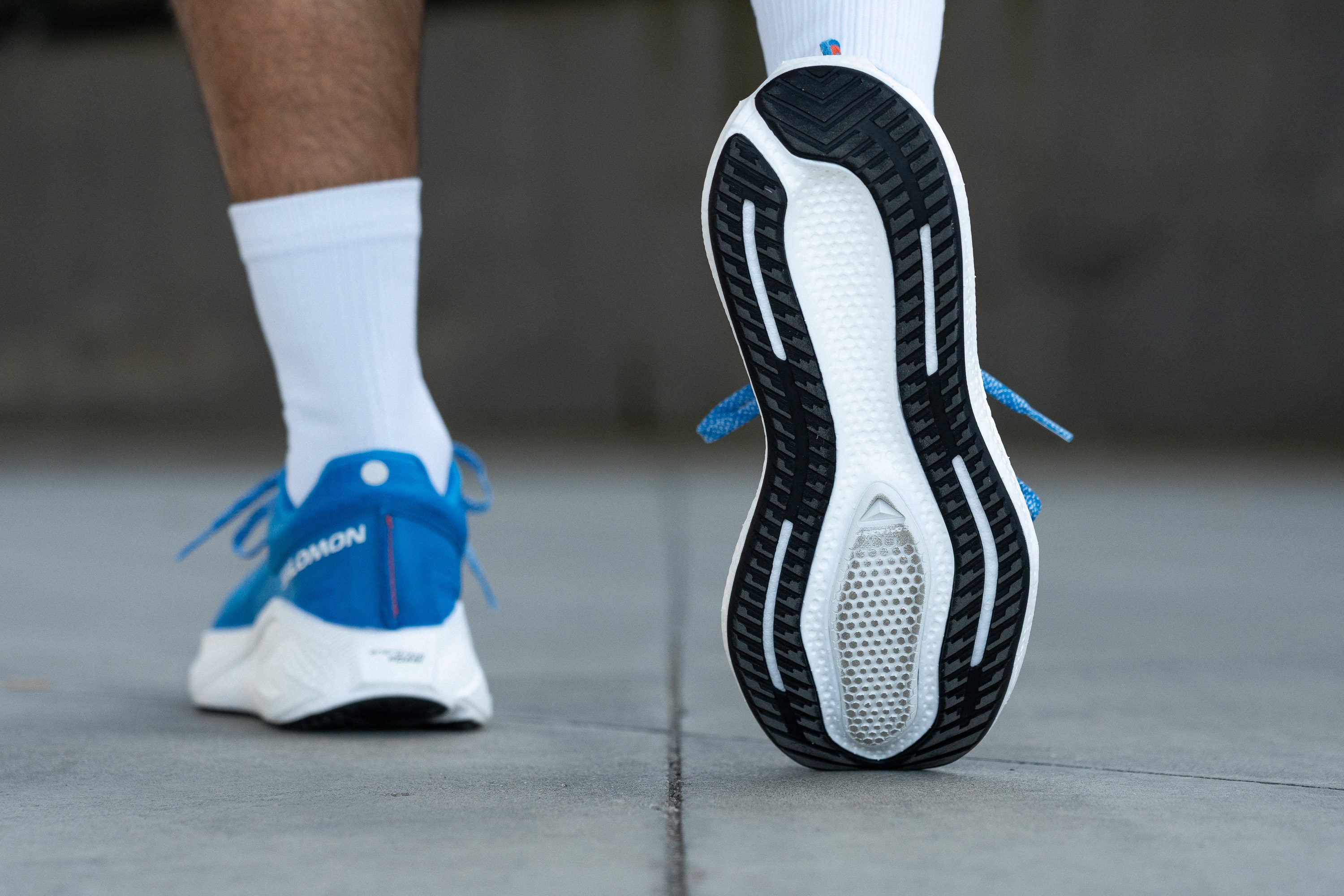
Flexibility / Stiffness
We tested the Aero Glide 3 using our precision-calibrated bend machine and recorded a force of 16.0N to achieve a 30-degree flex. This lands it in the average range.
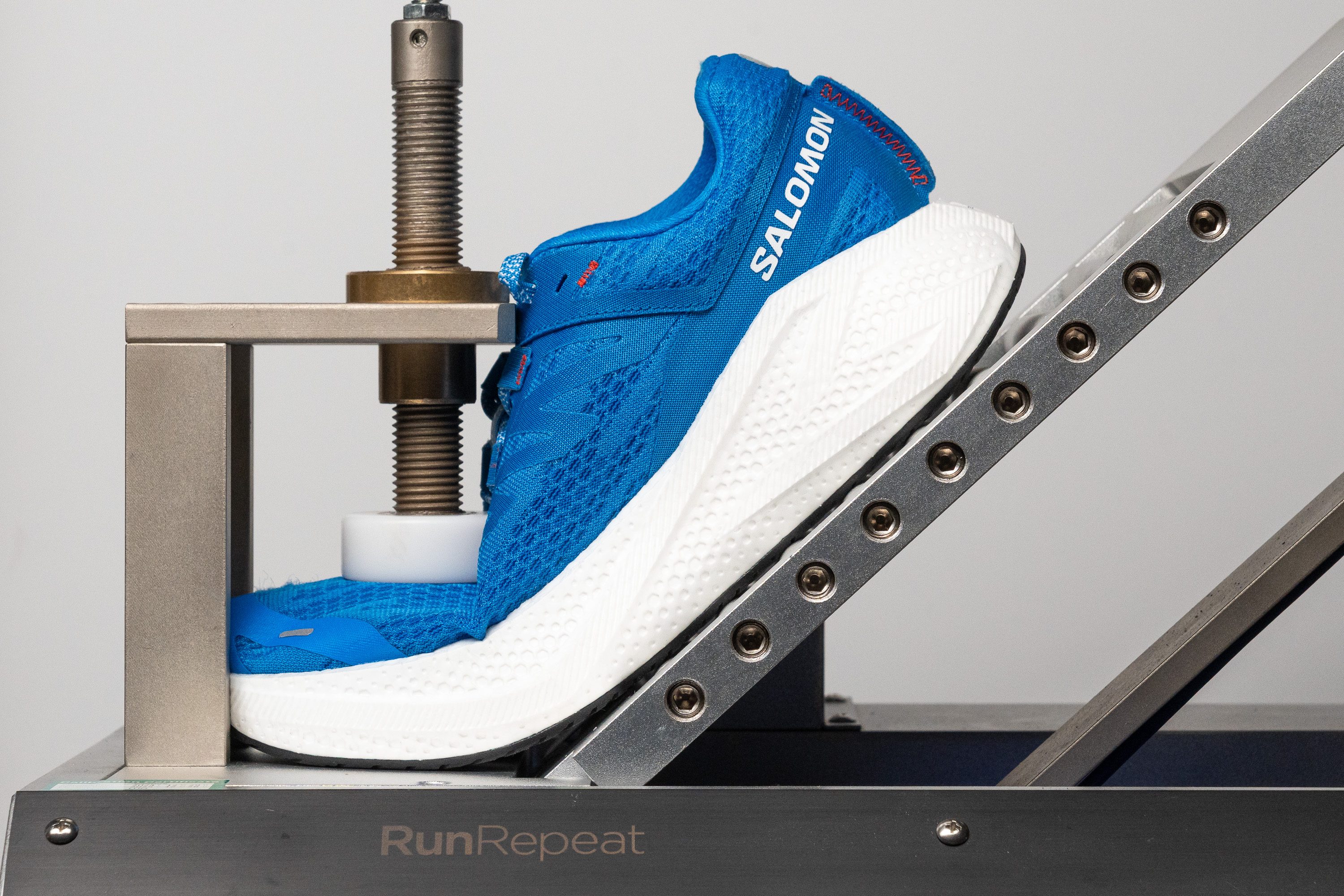
| Aero Glide 3 | 16.0N |
| Average | 15.2N |
Weight
Despite having a huge midsole in every dimension, the Aero Glide 3 keeps things impressively lightweight at just 8.7 oz or 248g. We discovered that Salomon crafted a true feather-built contender for the maximalist category as weight is clearly one of its standout strengths.
How did they make that possible? The updated foam plays a major role, the outsole trims off a chunk of rubber, and the upper uses a lighter mesh.

| Aero Glide 3 | 8.7 oz (248g) |
| Average | 9.3 oz (265g) |
Breathability
Salomon’s decades-deep experience with uppers clearly paid off: our breathability test revealed a strong 4/5 score, making the Aero Glide 3 a reliable all-season option, even during scorching-hot summer days.
The upper is built in two contrasting sections. The rear uses a dense and structured material to deliver rearfoot support, while the midfoot and forefoot feature a feather-light mesh to improve airflow and reduce weight.
We examined the shoe under our microscope and found an ultra-thin engineered mesh.
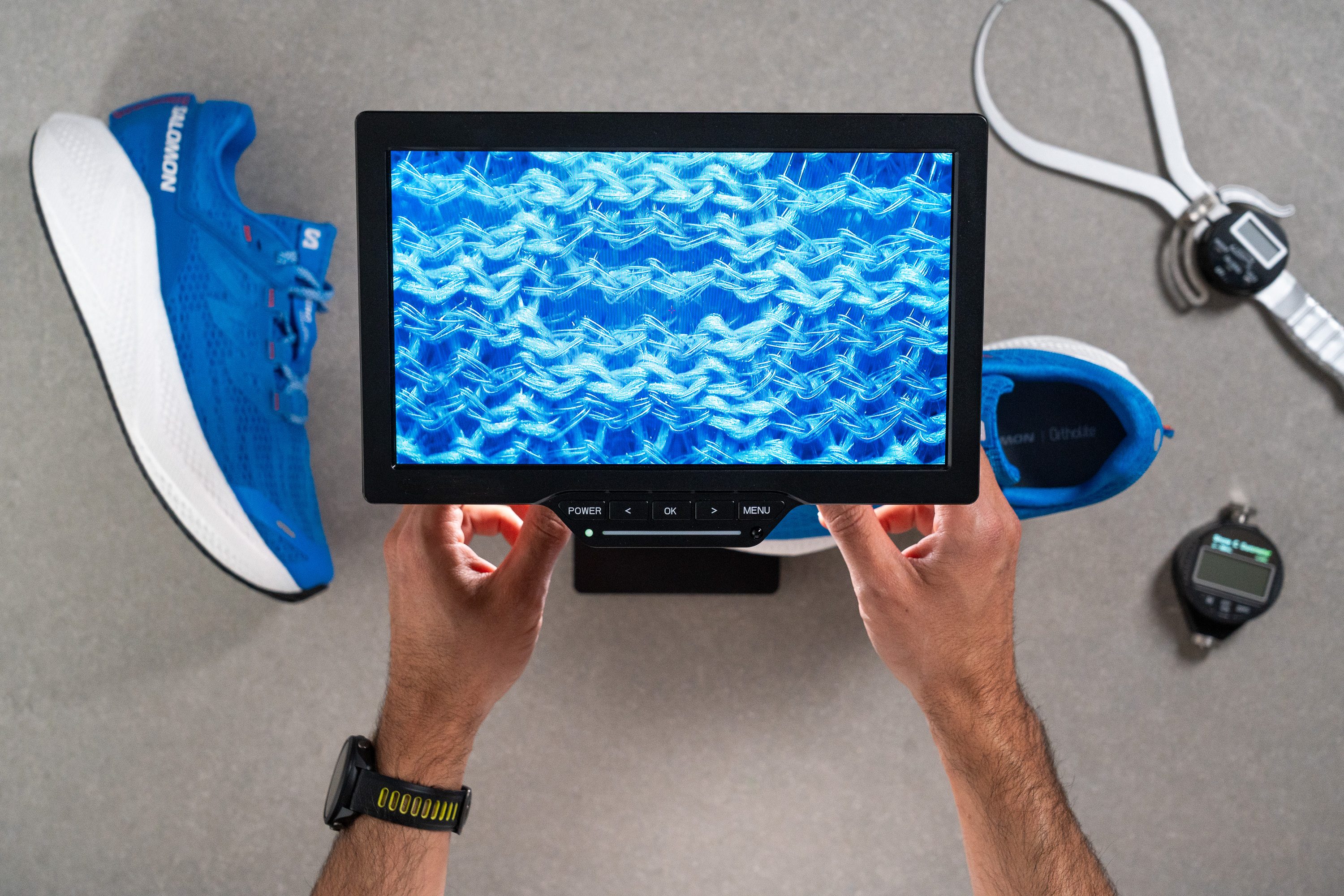
Based on our testing background, this airy design definitely raises some red flags regarding long-term durability.

We also discovered that while the upper provides solid comfort, Salomon intentionally reduced padding around the heel and tongue to trim some weight.
| Aero Glide 3 | 4 |
| Average | 3.7 |
Stability
Lateral stability test
The Aero Glide 3 is a neutral shoe that features subtle guidance elements like oversized heel sidewalls, a broad platform, and outsole guidance lines that help keep the foot centered. We recommend it for neutral runners, though mild pronators may also find it suitable.
Torsional rigidity
With such a high-stack midsole, we expected limited flexibility—and the 4/5 score in our torsional rigidity test confirms that’s a fair assessment.
| Aero Glide 3 | 4 |
| Average | 3.5 |
Heel counter stiffness
On the flip side, Salomon prioritized heel comfort over support, resulting in a rare 2/5 score in our test. This makes it a solid choice for runners with sensitive heels or Haglund’s deformity.
| Aero Glide 3 | 2 |
| Average | 2.9 |
Midsole width - forefoot
The shoe feels massive right out of the box. Up front, we measured a chunky 120.3 mm width in the forefoot—something that, not long ago, was seen only in stability-focused trainers and now is becoming normal even for daily trainers.
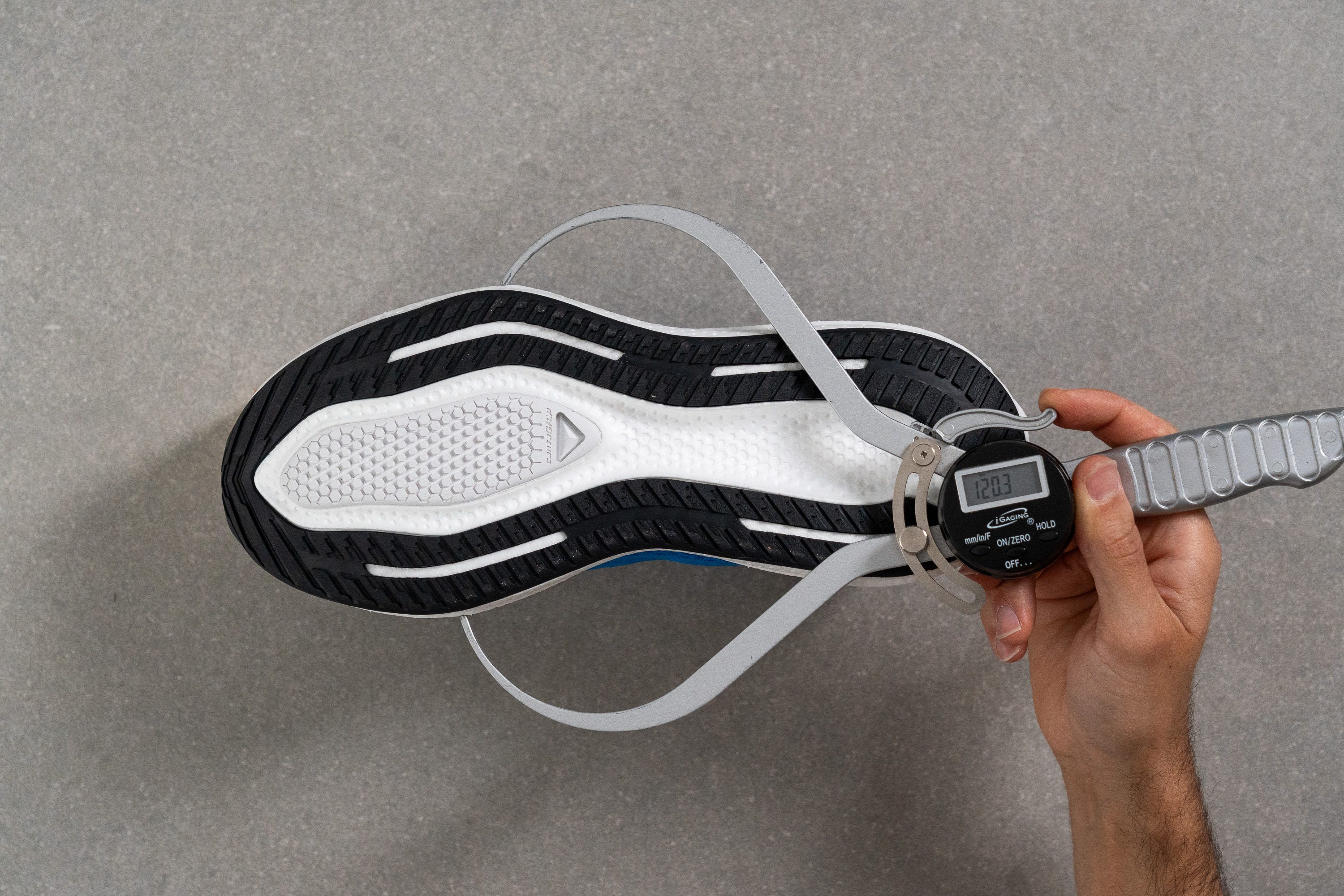
| Aero Glide 3 | 120.3 mm |
| Average | 114.3 mm |
Midsole width - heel
The same story continues in the heel, where we recorded a broad 96.2 mm width. This adds solid rearfoot stability to the sky-high platform—but naturally, it comes at the cost of agility. Not a match for nimble-shoe fans!
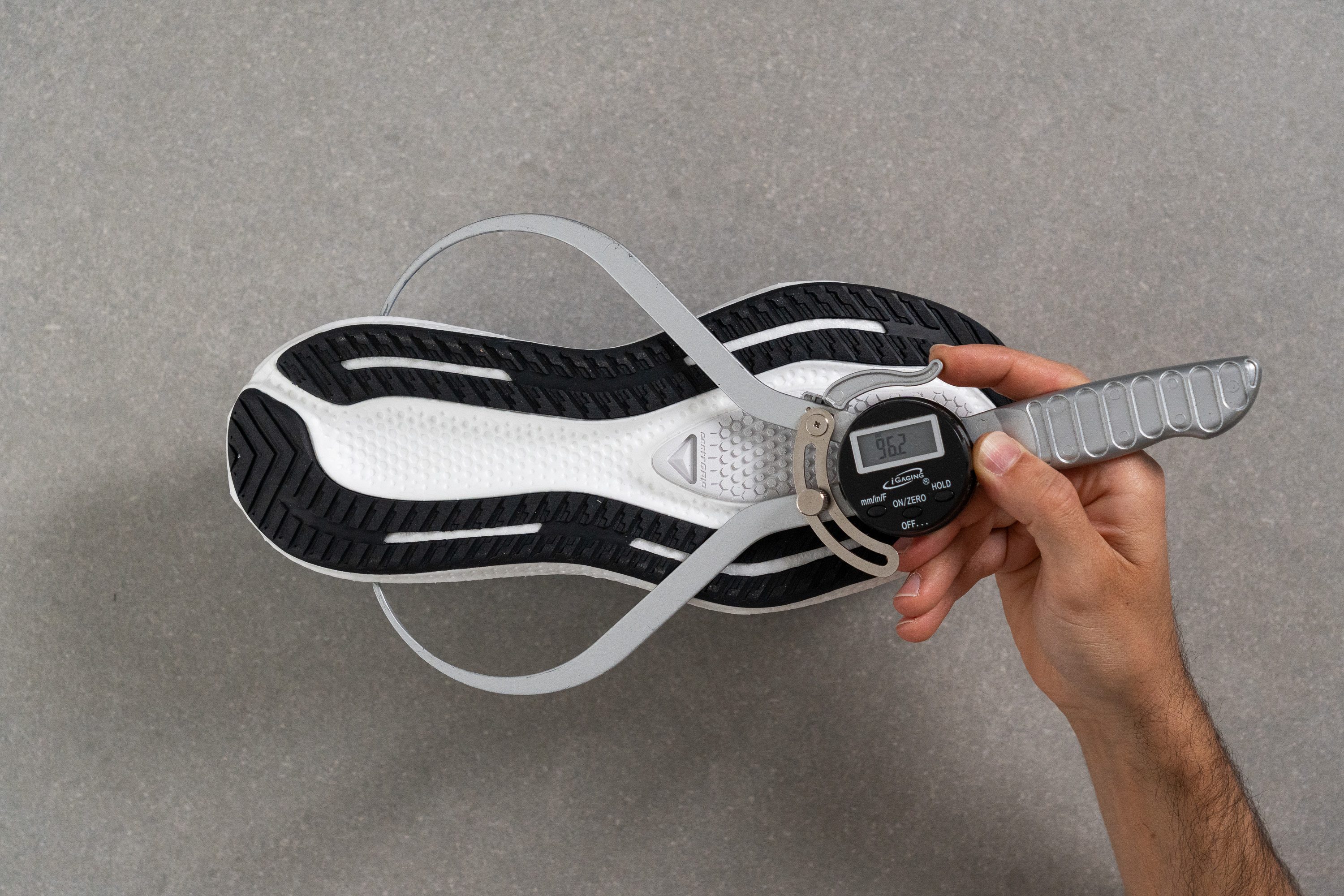
| Aero Glide 3 | 96.2 mm |
| Average | 90.7 mm |
Durability
Toebox durability
Our worst fears were confirmed the moment we brought out the Dremel. The upper disintegrated instantly, earning a rock-bottom 1 out of 5 in our durability test.
However, it’s worth noting that Salomon added a tough-and-protective TPU overlay to reinforce the toe cap.
| Aero Glide 3 | 1 |
| Average | 2.6 |
Heel padding durability
The heel padding of the Aero Glide 3 held up noticeably better, earning a respectable 3/5. While not groundbreaking, it offers dependable durability in this impact-prone zone.
| Aero Glide 3 | 3 |
| Average | 3.4 |
Outsole durability
We tested the outsole durability and found it to be one of the less exciting parts of the shoe—something that became obvious in our Dremel durability test. The result? A wear depth of 1.4 mm.
While that’s still within an acceptable range for average daily trainers, we like outsoles that dip below 1 mm.
| Aero Glide 3 | 1.4 mm |
| Average | 1.1 mm |
Outsole thickness
Salomon played it safe with a 3.9 mm outsole thickness, and given the underwhelming result from our Dremel test, we saw that as a smart move. It also makes us think that with a tougher, more durable rubber, they could easily trim the thickness and make this shoe even lighter.
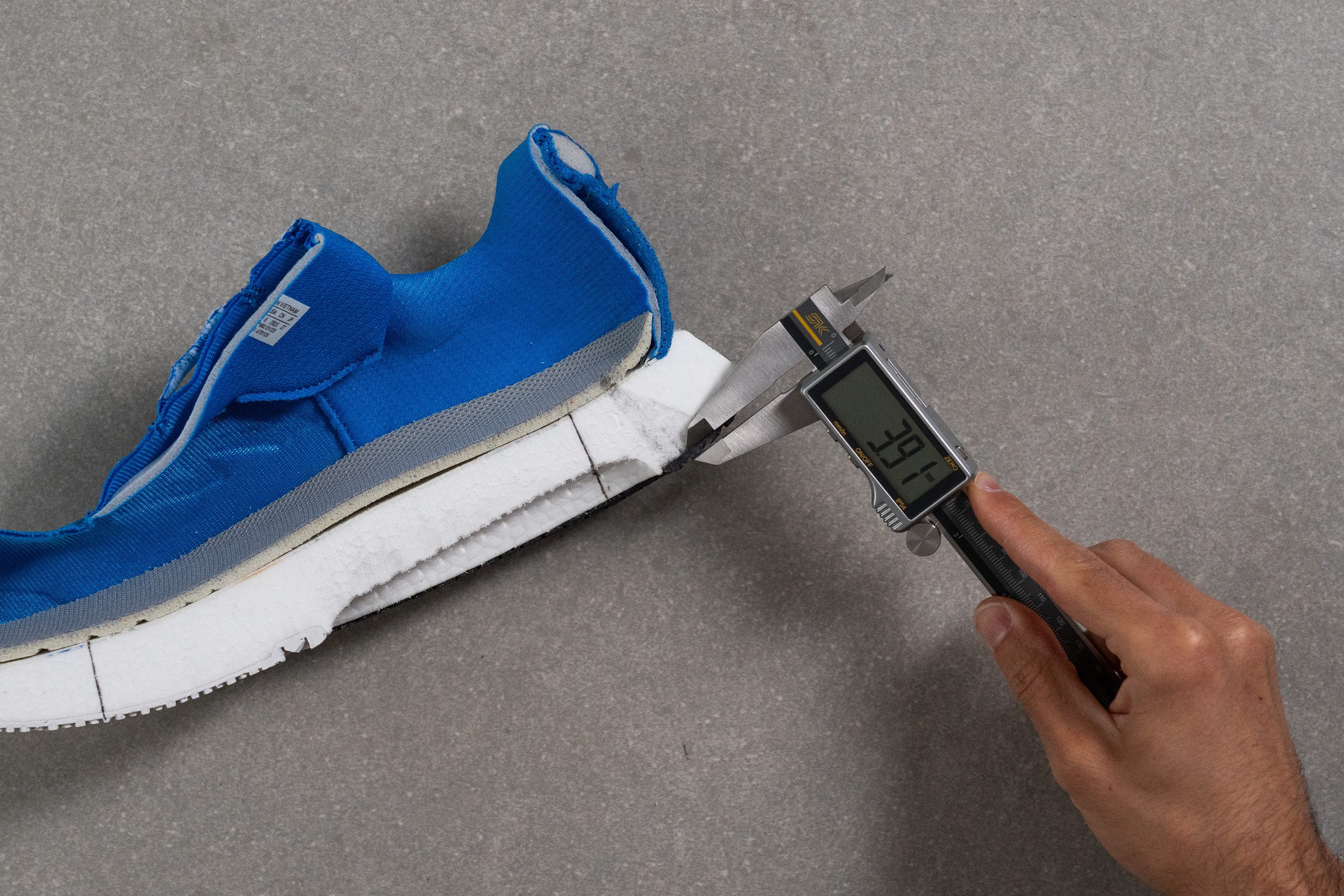
| Aero Glide 3 | 3.9 mm |
| Average | 3.2 mm |
Misc
Insole thickness
The Ortholite insole is made with recycled materials and measures 4.1 mm in thickness.
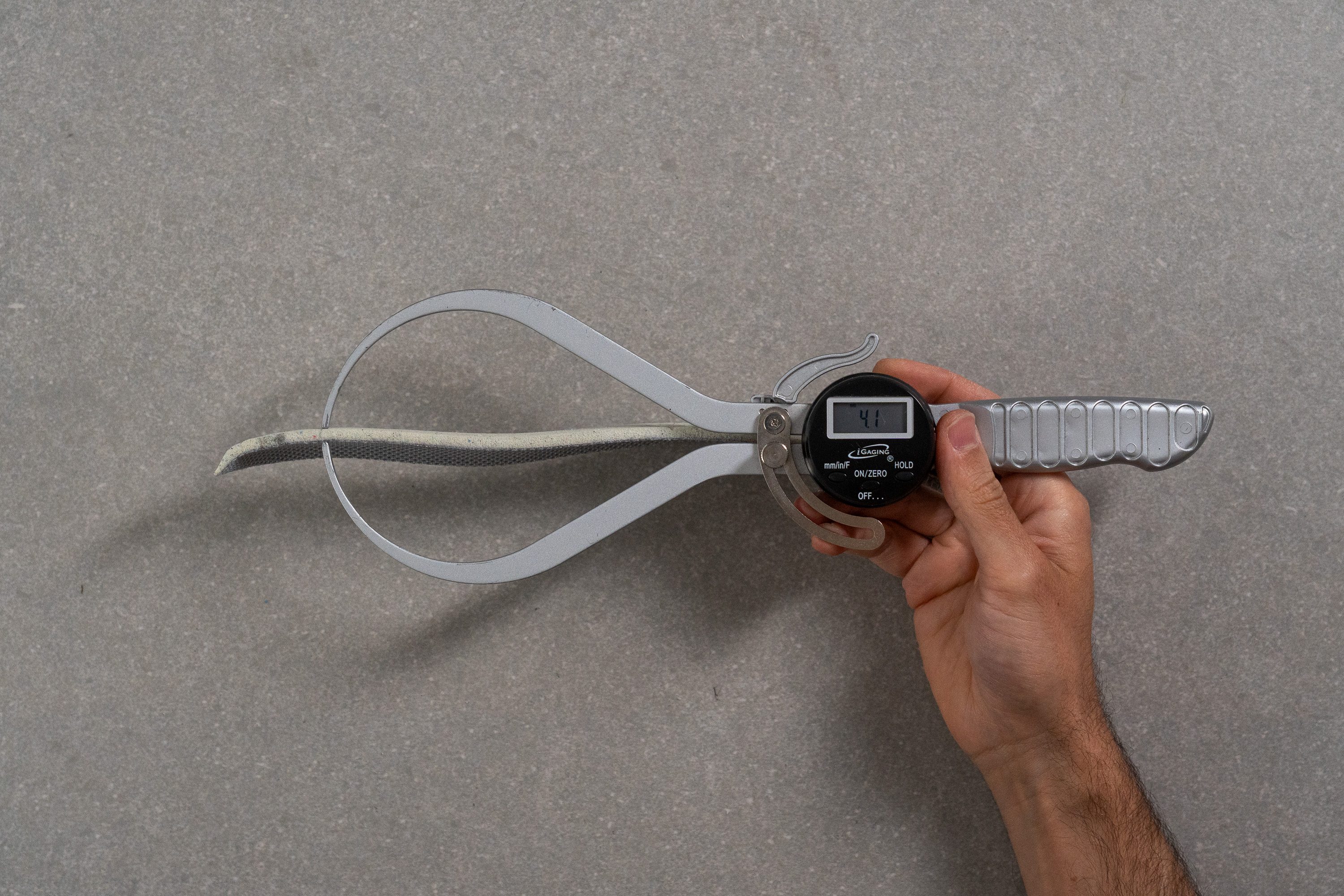
| Aero Glide 3 | 4.1 mm |
| Average | 4.5 mm |
Removable insole
The Ortholite insole isn’t glued down, so it’s easy to remove whenever you want.

| Aero Glide 3 | Yes |
Midsole softness in cold (%)
Thanks to the switch from EVA to eTPU, the Aero Glide 3 handles cold weather far better. After chilling for 20 minutes next to our ice creams, we measured only a 14% decrease in softness.
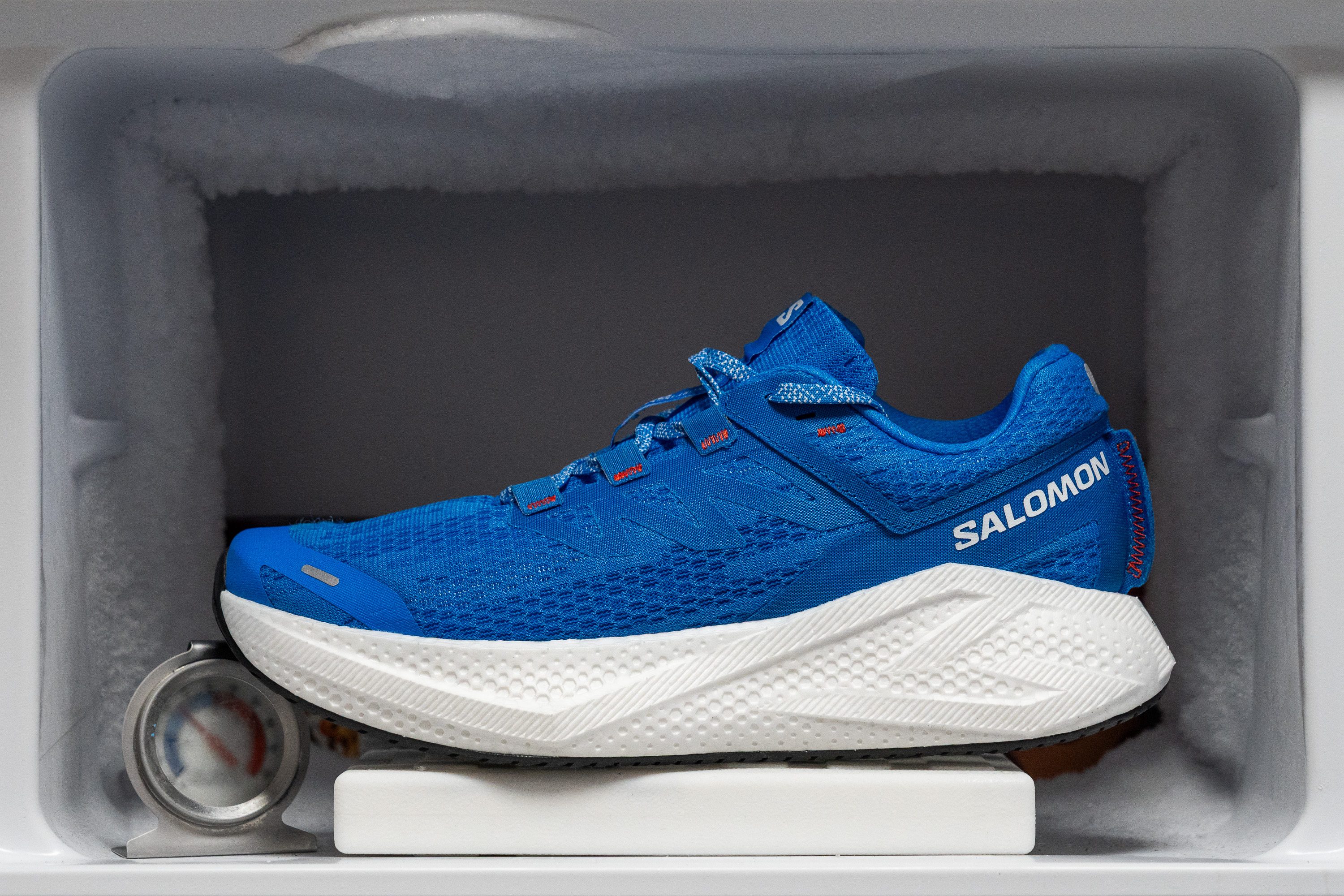
| Aero Glide 3 | 14% |
| Average | 25% |
Reflective elements
Another highlight we appreciated in the Aero Glide 3 is its 360-degree reflectivity—a standout safety feature that’s surprisingly rare among daily trainers.
| Aero Glide 3 | Yes |
Tongue padding
The tongue is relatively wide and decently cushioned at 6.4 mm, striking a balance between plush comfort and smart weight savings while doing a great job at relieving lace pressure.

Flat, trail-inspired laces weave through reinforced textile loops instead of classic eyelets, offering a snug-fitting lockdown through the midfoot—though they might feel slightly long for some runners. Each loop is anchored with red zig-zag stitching that reinforces the structure and adds a touch of rugged durability to the overall design.
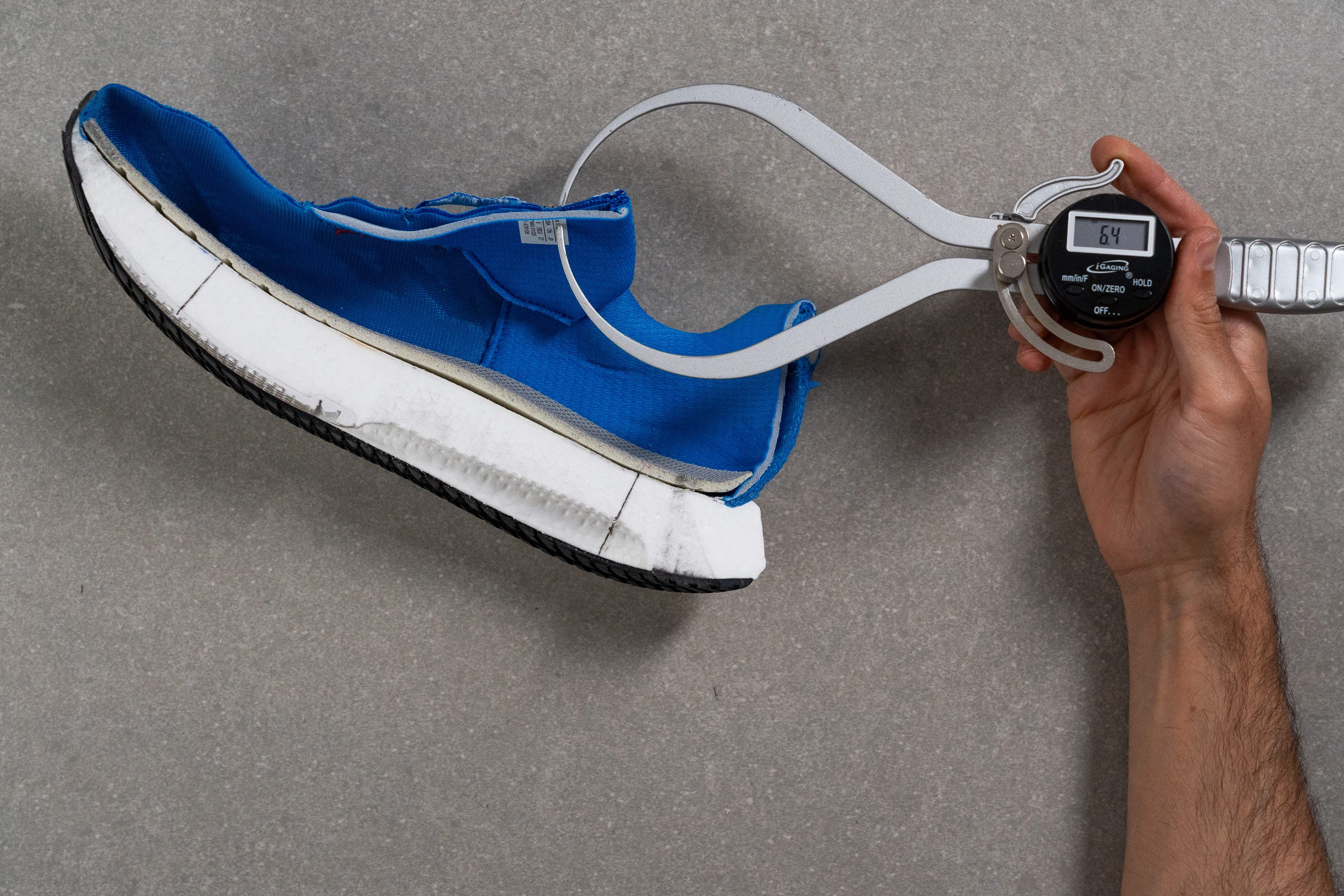
| Aero Glide 3 | 6.4 mm |
| Average | 5.8 mm |
Tongue: gusset type
The tongue is partially attached to the sides, and this is one of those details where we clearly felt Salomon’s trail-focused heritage. Instead of adding a fabric gusset, they directly stitched the upper to the tongue—just like in mountain-ready designs to block debris.
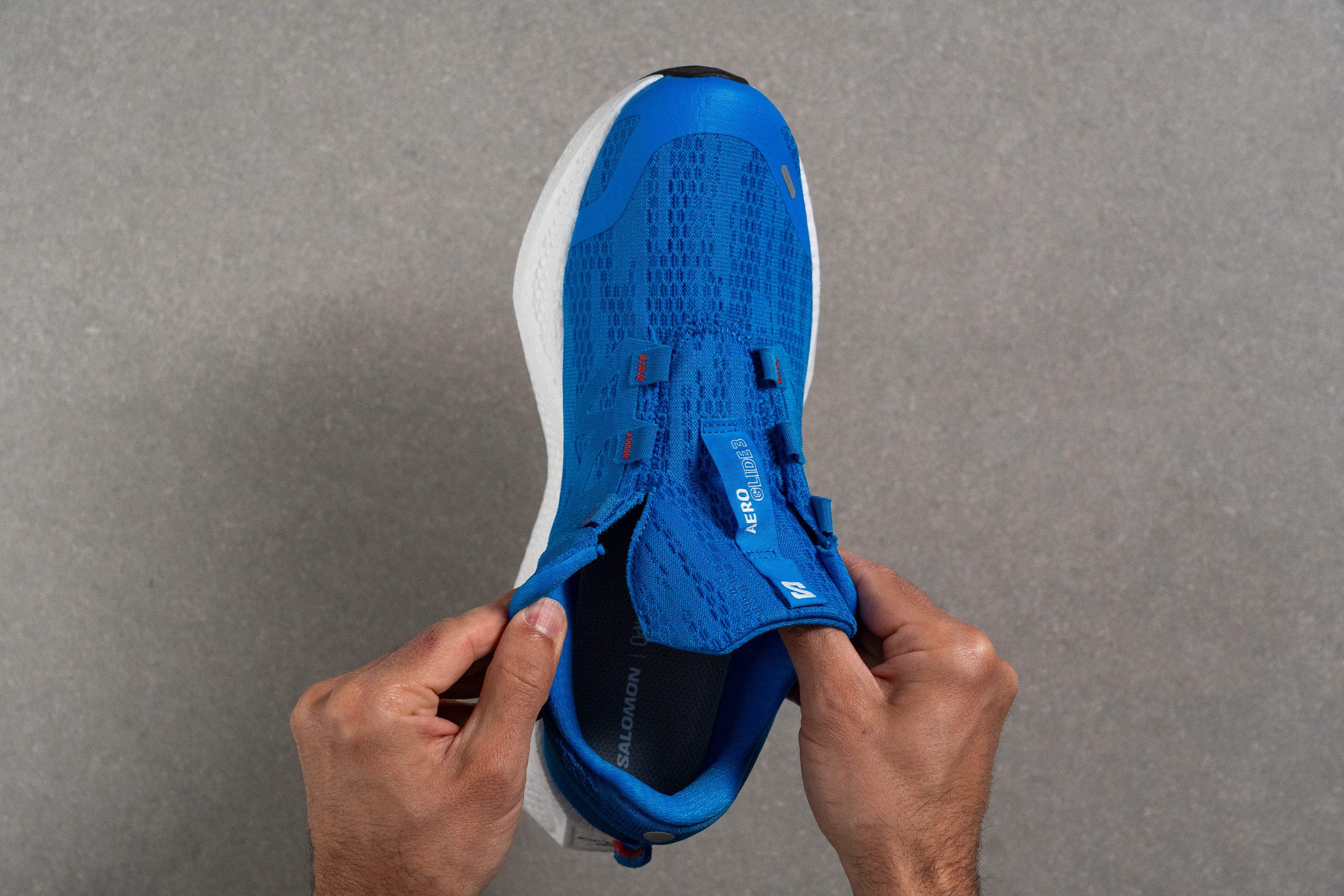
| Aero Glide 3 | Both sides (semi) |
Price
The Aero Glide 3 keeps the same price as the previous version, which we think is fair considering it was already on the high side for daily trainers. We didn’t expect a price cut, but we also can’t ignore that being more expensive than core competitors like the Nike Vomero 18 might hurt sales too.
| Aero Glide 3 | $160 |
| Average | $152 |
Heel tab
While there's no heel tab on this shoe, one of the coolest features we discovered in the Aero Glide 3 is its inside-out upper construction. This design leaves the stitching exposed on the outside of the heel, keeping the interior silky-smooth and irritation-free.

| Aero Glide 3 | None |

